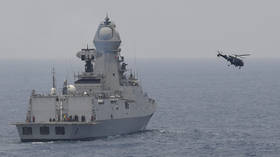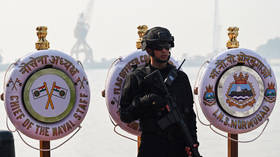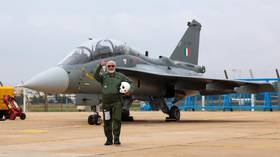India scaling up patrols in Arabian Sea – media

After pledging to “ensure” security in the Arabian Sea region in response to Houthi rebel attacks on merchant ships, the Indian Navy has reportedly increased its warship deployment.
Five guided missile destroyers are now monitoring the situation from the Red Sea to the Indian western coast, the Hindustan Times newspaper reported on Friday. Talking to the newspaper, officials monitoring these developments said the situation in the seas is on a “razor’s edge.”
The deployed vessels include INS Kolkata, near the Bab el-Mandeb chokepoint; INS Kochi, south of Yemen’s Socotra Island; INS Mormugao, in the western Arabian Sea; INS Chennai, in the central Arabian Sea; and INS Visakhapatnam, patrolling the North Arabian Sea region. The ships are receiving fuel from MV Swarnmala, a 25,000-tonne oil tanker.
This move follows previous deployments of three destroyers and the initiation of an investigation into the attack on MV Chem Pluto, a merchant vessel that was attacked off the Indian coast last Friday.
The Indian Navy is also carrying out surveillance using US-developed Boeing P8I anti-submarine warfare aircraft and an unarmed version of the Predator drone. According to reports, Dornier surveillance aircraft and off-shore patrol vessels are also being deployed to “maintain deterrence” in the Indian Exclusive Economic Zone (EEZ).
The destroyers deployed by India are believed to be equipped with BrahMos missiles, jointly developed by Russia and India. The BrahMos originally had a range of 290 km, subsequently extended to between 450km and 500km. Last month, New Delhi successfully test-fired an extended-range version of the missile from INS Imphal, India’s latest indigenous stealth guided-missile destroyer.
On Tuesday, Indian Defence Minister Rajnath Singh vowed to take “strict action” against those responsible for the attack on the MV Chem Pluto. “Whosoever masterminded the attack, we will find them from the bottom of the sea, and strict action will be taken against them,” Singh said at the launching ceremony of INS Imphal.
On Sunday, the White House alleged that the attack on the MV Chem Pluto, which had 20 Indians and a single Vietnamese individual on board, was orchestrated by Iran. Tehran vehemently rejected the allegations as “worthless.”
Meanwhile, the Indian Navy said that an explosive ordnance disposal team determined that the vessel had been attacked by a drone, and “further forensic and technical analysis” will be carried out later.
Merchant ships traversing the Red Sea route have been targeted by Houthi rebels, who claim to be expressing “solidarity” with civilians in Gaza, currently under siege. This follows Israel’s offensive in Gaza, which was initiated in response to an unprecedented attack by Hamas militants in October.
In response to the attacks by Houthis, the US has formed a naval task force comprising the UK, France, and other allies to protect merchant ships in the region. Shipping giants such as MSC, Maersk, CMA CGM, and Hapag-Lloyd suspended operations in the region after the attacks, but Maersk has announced its intention to resume operations in the Red Sea and the Gulf of Aden.
Where India Meets Russia – We are now on WhatsApp! Follow and share RT India in English and in Hindi














